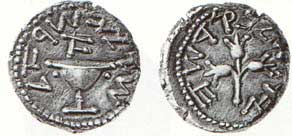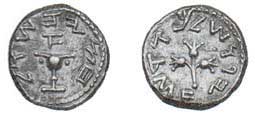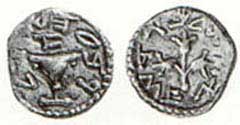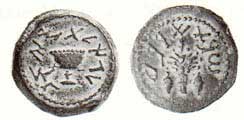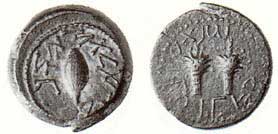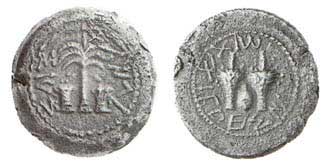First Revolt Shekel prototype, Year 1 (Brom. 56)
First Revolt Shekel, Year 1 (Brom. 57)
First Revolt Half Shekel, Year 1 (Herbst 1236)
First Revolt Quarter Shekel prototype, Year 1 (Brom. 62)
First Revolt Shekel, Year 2 (Brom. 63)
First Revolt Half Shekel, Year 2 (Herbst 1238)
First Revolt Shekel, Year 3 (Herbst 1240)
First Revolt Half Shekel, Year 3 (Herbst 1241)
First Revolt Shekel, Year 4 (Brom. 72)
First Revolt Half Shekel, Year 4 (Mesh2, 25)
First Revolt Quarter Shekel prototype, Year 4 (Mesh2, 26)
First Revolt Shekel, Year 5 (Ellenbogen 161) Bronze prutahs were issued in the second and third years of the revolt. They feature an amphora (uncovered on year 2, with a pointed cover on year 3), with the date and poignant Hebrew inscription “The Deliverance of Zion.”
First Revolt Prutah, Year 2 (Mesh2, 11)
First Revolt Prutah, Year 3 (Mesh2, 20) Finally, there are three sizes of larger bronze coins, minted in the fourth year of the revolt, presumably when the supply of silver was running low. The smallest does not have a denomination indicated, but is usually referred to as an Eighth (Shekel?). It is assumed that all of these denominations are fractions of a shekel. Like the silver coins, a chalice is featured, along with symbols of the harvest festival of Succoth - lulav (bunch of branches) and etrog (lime-like fruit). The date and inscription “For the Redemption of Zion”" are inscribed. The medium bronze has the same inscriptions, with the denomination “Reva” (Quarter) indicated; a large etrog is depicted on the obverse, and two lulav are shown on the reverse. The largest bronze coins are inscribed “Chatzi” (Half); again the lulav and etrog are pictured on one side, with a palm tree and baskets on the reverse.
First Revolt Eighth?, Year 4 (Brom. 77)
First Revolt Quarter, Year 4 (Brom. 76)
Sources: The Handbook of Biblical Numismatics |

